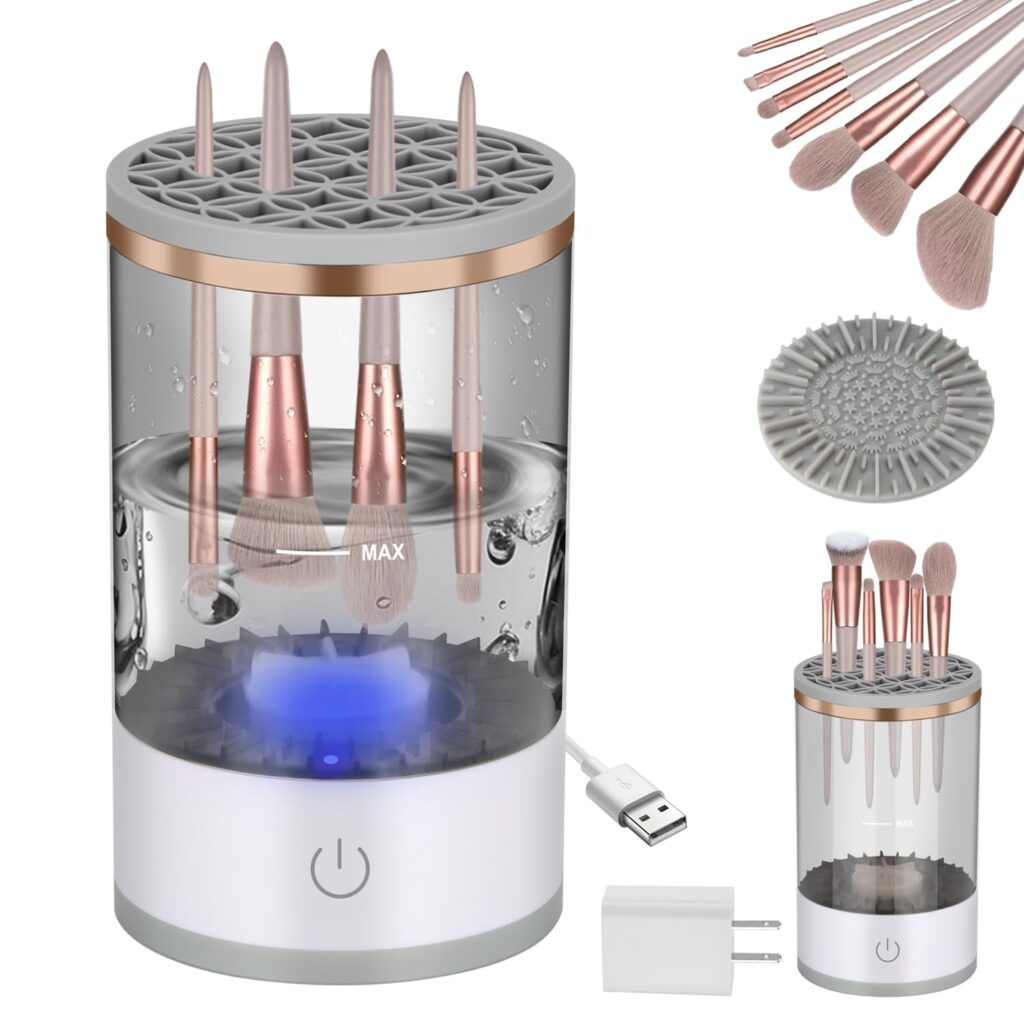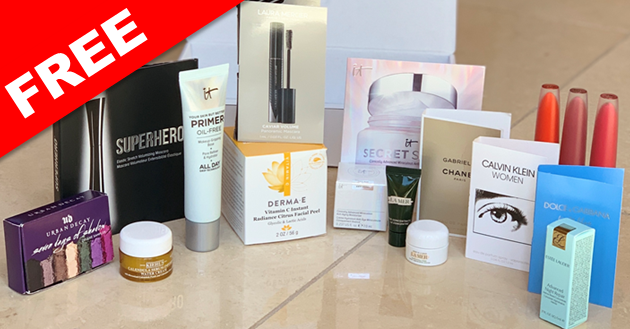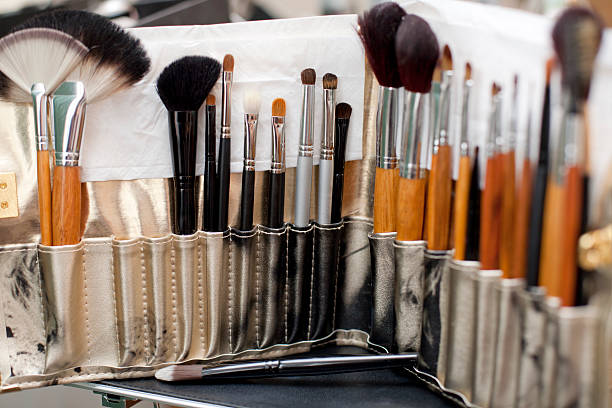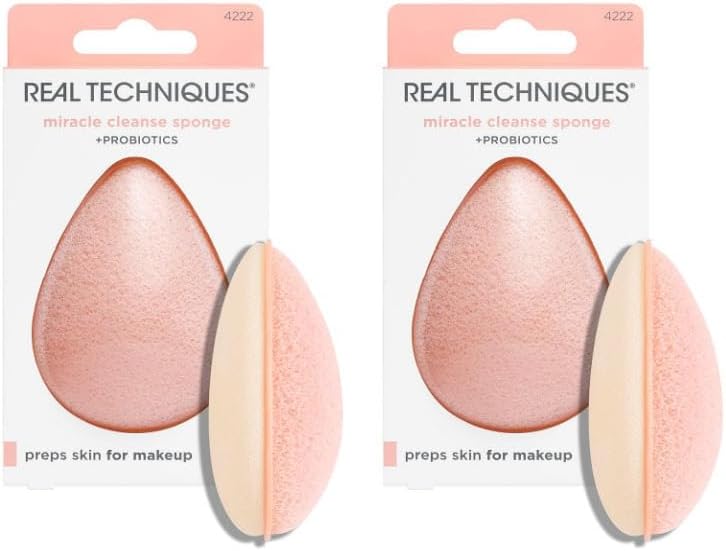Keeping your makeup brushes clean is an essential part of any beauty routine. Not only does it prevent makeup mishaps (think muddy eyeshadow!), but it also helps prevent breakouts and infections.
Your guide to maintaining sparkling clean brushes:
Brush Cleaners: A Buyer’s Guide
- e.l.f…Makeup Brush Shampoo:
- This Shampoo Washes Away Dirt, Makeup, Oil & Debris & Conditions Bristles, Crafted For Daily Use, Vegan & Cruelty-Free, 4.1 Fl Oz
- EcoTools Makeup Brush and Sponge Shampoo :
- EcoTools Makeup Brush plus Sponge Shampoo effectively removes makeup, dirt, oil, and other impurities from your makeup tools- without all the harsh chemicals.
- Electric Makeup Brush Cleaner, Cosmetic Brush Cleaner Machine :
- High Quality Makeup Brush Cleaner】Our makeup brush cleaner utilizes state-of-the-art technology to ensure a thorough and gentle cleansing of your makeup brushes. The powerful yet gentle motor rotates and cleans each bristle, removing makeup residue, oil, and impurities

Other Great Cleansers
- Real Techniques Brush + Sponge Cleansing Gel:
- The Real Techniques Makeup Brush and Blending Sponge Cleansing Gel was made to help improve your brush performance.
- Facial Cleansing Brush Silicone Face Scrubber:
- EASY CLEANSING FOR BEST SKIN: COSLUS facial cleansing brush is made of super soft food-grade silicone, suitable for all skin types. The silicone face scrubber can be effective removes 99.9% of dirt, oil and dead skin. It can meet various cleaning and skin care needs such as removing blackheads, exfoliating, pore cleaning, massage etc. Improving your facial skin health up to 100%
The Benefits of Textured Cleansing Mats for Brush Cleaning
Textured cleansing mats are a game-changer in the realm of brush maintenance. These mats, designed with various grooves and ridges, offer a deep-cleaning experience that surpasses traditional hand-washing methods.
Enhanced Cleaning Efficiency
The textured surfaces tackle even the most stubborn makeup residues and dirt embedded in the bristles. By using a mat, you can gently scrub each brush against these textures, effectively removing build-up without damaging your tools.
User-Friendly Design
Many mats are crafted to fit comfortably in your hand, making them easier to maneuver while cleaning. This ergonomic design ensures you maintain control over the cleaning process, resulting in a more thorough wash.
Time-Saving
The efficiency of textured cleansing mats allows you to clean multiple brushes quickly, saving valuable time. Their versatile textures are designed to accommodate a variety of brush sizes and types.
In Summary
Incorporating a textured cleansing mat into your brush-cleaning routine not only enhances hygiene but also prolongs the lifespan of your brushes, making it a smart addition to your beauty toolkit.
How Do Dirty Makeup Brushes Cause Cross-Contamination with Other Makeup Products?
Dirty makeup brushes can act as a bridge for spreading unwanted substances across your cosmetics. Here’s how this happens:
- Bacterial Transfer: Used brushes can harbor bacteria that, when dipped into another product, contaminate it. This allows germs to multiply and spread, potentially leading to skin irritation or infections.
- Spread of Oil and Dirt: Brushes collect oils and dirt from your skin. If not cleaned, these impurities can be transferred to your products, degrading their quality over time.
- Mixing Residues: When a brush is used with multiple products without being cleaned, residues from one product can be mixed into another. This not only alters the intended color and consistency but can also affect the performance of the makeup.
Regularly cleaning your brushes is essential to safeguard the integrity of your makeup collection and ensure a safe and healthy beauty routine.

Ethical Elegance in Cruelty-Free Beauty: Transparency and Sustainability at the Forefront
Facial Cleansing Brush Silicone Face Scrubber

How Often Should You Clean Your Brushes?
In a survey conducted by the Huffington Post, it was found that 61% of women clean their makeup brushes at least once a month. Meanwhile, the remaining portion either clean them less frequently or not at all. Specifically, 39% clean their brushes less than monthly, with 22% admitting they never clean them.
Dermatologists recommend cleaning your brushes regularly. Here’s a general guide:
- Why weekly cleaning is ideal, especially for brushes used around the eye area or with heavy makeup application:
- Eye Area Sensitivity: The skin around the eyes is much thinner and more delicate than the skin on the rest of your face. It’s more prone to irritation and infection. Dirty brushes harbor bacteria and dead skin cells, which can easily transfer to the sensitive eye area and cause irritation, styes, or even conjunctivitis (pink eye).
- Heavy Makeup Buildup: Brushes used for foundation, concealer, or cream blushes tend to hold onto more product compared to eyeshadow brushes. This buildup can clog the pores and lead to breakouts, especially if the brush isn’t cleaned regularly.

Top Essential Vegan Skincare Products for All Skin Types
Bonus Tip: Clean Makeup Application Starts with Clean Brushes
Dirty brushes can lead to uneven makeup application that appears streaky or difficult to blend. Clean brushes ensure a flawless, even finish.
Washing Your Brushes: A Step-by-Step Guide
- “Wet the brush bristles or sponge with warm water.” Start by holding your makeup brush under a gentle stream. Be sure to angle the brush downward to prevent water from seeping into the handle, as this could loosen the glue holding the bristles.
- While wetting, avoid fully submerging the brush in water. This simple step helps maintain the longevity of your brushes, ensuring they stay in top condition for flawless makeup application.
- Once the bristles are thoroughly wet, you’re ready for the next step in your brush cleaning routine.
- Apply a small amount of cleanser or shampoo to your palm. Choose a gentle formula to prevent damage to the bristles.
- Rub the cleanser onto your hand and gently swirl the brush bristles in circular motions. This motion is crucial for effectively distributing the soap throughout the bristles, ensuring all makeup and impurities are lifted away.
- Rinse the bristles thoroughly with warm water. Make sure all soap is removed to prevent residue build-up.
- Gently reshape the brush head back to its original form. Avoid squeezing or using a towel, which can damage the bristles.
- Lay the brushes flat on a clean surface with the bristles hanging off the edge to dry. Avoid drying them on a towel (which can cause mold) or standing upright (which can change their shape). Never use a hairdryer to speed up drying!
By following these steps, you’ll ensure your makeup brushes remain clean and in great condition, enhancing both their longevity and performance.
How to Ensure Your Makeup Brushes Are Thoroughly Rinsed
- Initial Rinse: Start by holding the brush under lukewarm running water with the bristles pointing downward. This prevents water from seeping into the handle, which can weaken the glue.
- Gentle Squeeze: After the initial rinse, gently squeeze the bristles to remove excess water. This helps to prevent product build-up at the base of the bristles.
- Apply Cleanser: Use a gentle brush cleanser like those from Sigma Beauty or EcoTools. Apply a small amount to your palm or a cleaning mat.
- Work Up a Lather: Swirl the brush in the cleanser, ensuring that you work up a good lather. This helps to lift any stubborn residue trapped within the bristles.
- Final Rinse: Hold the brush under running water again. Continue rinsing until the water runs clear. If needed, repeat the cleansing and rinsing steps until no soap or makeup remains.
- Dry Correctly: Once clean, reshape the bristles and lay the brush flat on a towel to dry. Avoid standing them upright as water can still damage the brush handle.
Following these steps ensures your brushes remain in top condition, extending their lifespan while maintaining hygiene.
Removing Excess Water from Makeup Brushes After Cleaning
Once your makeup brushes are freshly cleaned, it’s important to get rid of any excess water to avoid damaging the bristles and ensure they dry properly.
- Squeeze Out Water
Gently squeeze the bristles between your fingers. This helps to release any remaining water without tugging or pulling on the hairs of the brush. - Drying the Brushes
Lay the brushes flat on a clean paper towel or a soft cloth. It’s crucial to let them air dry in this position overnight to maintain their shape and ensure they’re completely dry by the next day.
By following these steps, your makeup brushes will be ready and safe to use again in the morning.
How to Make Cleaning Your Makeup Brushes an Enjoyable Experience
Cleaning makeup brushes often feels like a chore, but it doesn’t have to be. Transform this task into a delightful ritual with a few simple strategies.
1. Mix Pleasure with Productivity:
- Multi-Task Like a Pro: Plan to do another enjoyable activity while cleaning your brushes. This could include applying a soothing face mask or doing a quick meditation session.
2. Engage Your Senses:
- Tune into Entertainment: Pop on your favorite podcast or curated playlist to keep your mind entertained. Alternatively, chat with a friend on a hands-free call.
3. Enjoy the Satisfaction:
- See the Results: Focus on the gratifying transformation. Watching your brushes go from grimy to gleaming is rewarding and adds a visual incentive to finish the task.
By integrating these approaches, you’ll not only make the process more enjoyable but also ensure your makeup tools are consistently fresh and hygienic.
Can You Use Regular Shampoo?
A gentle, soap-free, or baby shampoo can be used in a pinch. Avoid your regular shampoo, as it can be too harsh for the delicate bristles. Baby shampoos are particularly beneficial because they’re formulated to be gentle, making them ideal for cleaning brushes without damaging them. This is especially important for natural fiber brushes, which require a soft touch to maintain their quality and longevity.
By using baby shampoo, you ensure that the bristles remain intact and soft, allowing for effective makeup application every time. The mild formula effectively removes makeup residue while protecting the brush’s integrity.
Why is Dish Soap Effective for Cleaning Certain Makeup Tools?
Dish soap is a powerful ally in ensuring your makeup tools remain squeaky clean and free of residue. But why exactly is it so effective?
- Strong Degreasing Properties: Dish soap is formulated to cut through grease and oil, making it ideal for removing oil-based makeup products from sponges and brushes. This capability ensures that your tools are thoroughly cleansed.
- Gentle on Materials: While it’s tough on grime, dish soap remains gentle enough not to damage the delicate materials of your beauty blenders and sponges. It’s balanced to maintain the integrity of these tools while still delivering a deep clean.
- Versatile Application: In addition to liquid foundations and concealers, dish soap effectively cleans a variety of makeup residues. Its versatility ensures you can rely on it for multiple tools and products.
- Readily Available and Economical: With most households already stocked with dish soap, it’s a convenient and cost-effective option for routine maintenance of your beauty tools.
By breaking down the stubborn residues that can accumulate on your makeup tools, dish soap helps maintain them in top condition, ensuring optimal performance and hygiene.

Freeflys: Discover Free Beauty Product Samples from L’Oréal, Olay, and NARS
Keeping Your Brushes Sparkling Clean: Tips from the Pros
- Cleanse regularly to prevent bacteria buildup.
- Choose a cleaning method that suits your budget and preferences.
- Clean brushes used around the eyes more frequently.
- Air dry your brushes properly to prevent mold and damage.
By following these tips, you can keep your makeup brushes clean and ensure a flawless makeup application every time.
Keeping Your Makeup Brushes Sparkling Clean: A Summary
This article guides you through the importance of cleaning your makeup brushes and maintaining good brush hygiene. Here are the key takeaways:
- Clean Brushes for Flawless Makeup: Dirty brushes can lead to uneven makeup application, streaks, and difficulty blending. Clean brushes ensure a flawless finish.
- Benefits of Clean Brushes: Regular cleaning prevents bacteria buildup, reduces the risk of breakouts and infections (especially around the eyes), and extends the life of your brushes.
- How Often to Clean: Weekly cleaning is ideal, especially for brushes used around the eyes or with heavy makeup application (foundation, concealer, cream blushes). Brushes used less frequently can be cleaned bi-weekly or monthly.
- Brush Cleaning Products: There are various brush cleansers available, from budget-friendly options like rubbing alcohol to luxurious choices with added benefits like conditioning. You can even use a gentle, soap-free shampoo in a pinch.
- Washing Your Brushes: Here’s a quick guide on how to wash your brushes:
- Wet bristles with warm water.
- Apply cleanser to your palm.
- Swirl the brush in the cleanser.
- Rinse thoroughly with warm water.
- Reshape brush head gently.
- Lay brushes flat to dry (not on a towel or standing upright).
By following these tips, you can keep your makeup brushes clean and ensure a flawless makeup application every time.
FAQ:
General Questions
Q: Why is it important to clean my makeup brushes? A: Cleaning your makeup brushes is crucial for several reasons: * Hygiene: Dirty brushes harbor bacteria that can lead to skin infections, especially around the delicate eye area. * Makeup Application: Clean brushes ensure a smooth and even application of makeup, preventing streaky or patchy results. * Product Longevity: Regular cleaning extends the lifespan of your makeup brushes by removing product buildup that can degrade the bristles.
Q: How often should I clean my makeup brushes? A: It’s recommended to clean your brushes at least once a week, especially those used for foundation, concealer, and eye makeup. Brushes used less frequently can be cleaned every two weeks.
Q: Can I use regular shampoo to clean my makeup brushes? A: While a gentle, soap-free shampoo can be used in a pinch, it’s best to use a specialized brush cleaner or a gentle cleanser formulated for makeup brushes. Regular shampoo can be too harsh and may damage the bristles.
Product-Specific Questions
Q: What is the best brush cleaner for sensitive skin? A: Look for a gentle, fragrance-free brush cleaner that won’t irritate your skin. Products with natural ingredients like tea tree oil or aloe vera can be soothing.
Q: How do I use an electric brush cleaner? A: Electric brush cleaners are easy to use. Simply fill the cleaning solution, insert your brush, and let the machine do the work. The rotating motion effectively removes makeup residue and bacteria.
Q: Can I use a facial cleanser to clean my makeup brushes? A: While a gentle facial cleanser can be used in a pinch, it may not be as effective as a specialized brush cleaner. Facial cleansers are often designed for skin, not makeup brushes, so they may not remove all the makeup residue.
Tips and Tricks
Q: How can I dry my brushes quickly without damaging them? A: To dry your brushes quickly, lay them flat on a clean towel with the bristles hanging over the edge. Avoid using a hairdryer, as the heat can damage the bristles.
Q: How can I prevent my brushes from shedding? A: To prevent shedding, avoid using harsh detergents and excessive force when cleaning your brushes. Store your brushes in a cool, dry place to maintain their shape and prevent damage.
By following these tips and regularly cleaning your makeup brushes, you can ensure a flawless and hygienic makeup application every time.

Find more articles like this @ Where And How Resources



